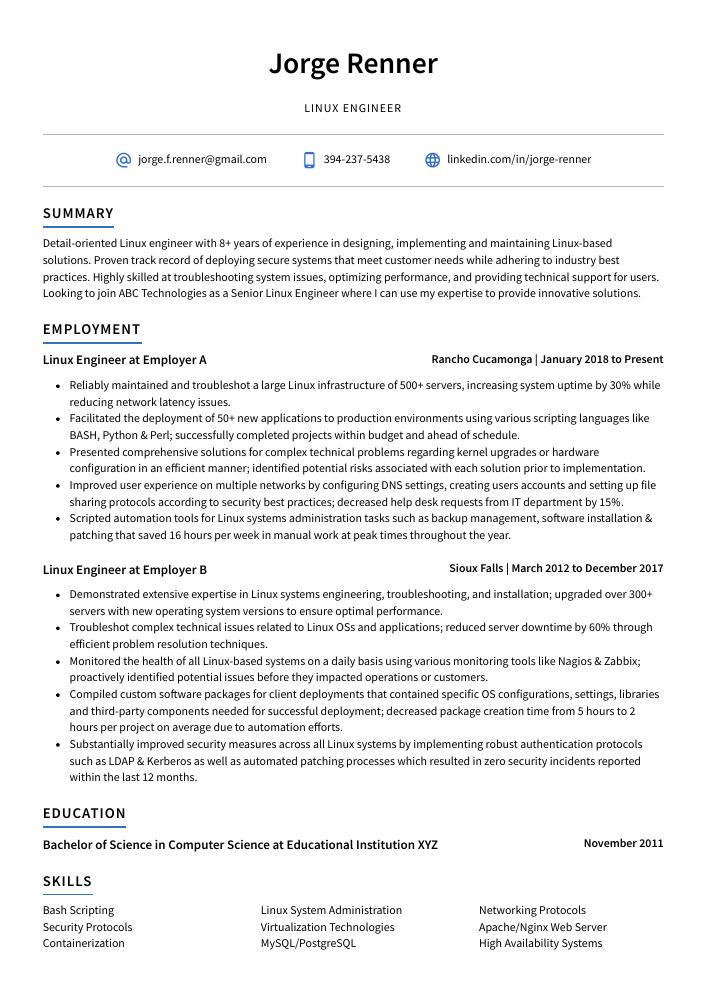Linux Engineer Resume Guide
Linux engineers design, develop and maintain the computer systems that use the Linux operating system. They create scripts to automate processes, troubleshoot technical issues related to software or hardware malfunctions, configure networks for optimal performance and provide support for users.
You have a knack for Linux engineering and could be an asset to any IT department. But hiring managers don’t know how great you are yet, so you must write a resume that makes them take notice of your skills.
This guide will walk you through the entire process of creating a top-notch resume. We first show you a complete example and then break down what each resume section should look like.
Table of Contents
The guide is divided into sections for your convenience. You can read it from beginning to end or use the table of contents below to jump to a specific part.
Linux Engineer Resume Sample
Jorge Renner
Linux Engineer
jorge.f.renner@gmail.com
394-237-5438
linkedin.com/in/jorge-renner
Summary
Detail-oriented Linux engineer with 8+ years of experience in designing, implementing and maintaining Linux-based solutions. Proven track record of deploying secure systems that meet customer needs while adhering to industry best practices. Highly skilled at troubleshooting system issues, optimizing performance, and providing technical support for users. Looking to join ABC Technologies as a Senior Linux Engineer where I can use my expertise to provide innovative solutions.
Experience
Linux Engineer, Employer A
Rancho Cucamonga, Jan 2018 – Present
- Reliably maintained and troubleshot a large Linux infrastructure of 500+ servers, increasing system uptime by 30% while reducing network latency issues.
- Facilitated the deployment of 50+ new applications to production environments using various scripting languages like BASH, Python & Perl; successfully completed projects within budget and ahead of schedule.
- Presented comprehensive solutions for complex technical problems regarding kernel upgrades or hardware configuration in an efficient manner; identified potential risks associated with each solution prior to implementation.
- Improved user experience on multiple networks by configuring DNS settings, creating users accounts and setting up file sharing protocols according to security best practices; decreased help desk requests from IT department by 15%.
- Scripted automation tools for Linux systems administration tasks such as backup management, software installation & patching that saved 16 hours per week in manual work at peak times throughout the year.
Linux Engineer, Employer B
Sioux Falls, Mar 2012 – Dec 2017
- Demonstrated extensive expertise in Linux systems engineering, troubleshooting, and installation; upgraded over 300+ servers with new operating system versions to ensure optimal performance.
- Troubleshot complex technical issues related to Linux OSs and applications; reduced server downtime by 60% through efficient problem resolution techniques.
- Monitored the health of all Linux-based systems on a daily basis using various monitoring tools like Nagios & Zabbix; proactively identified potential issues before they impacted operations or customers.
- Compiled custom software packages for client deployments that contained specific OS configurations, settings, libraries and third-party components needed for successful deployment; decreased package creation time from 5 hours to 2 hours per project on average due to automation efforts.
- Substantially improved security measures across all Linux systems by implementing robust authentication protocols such as LDAP & Kerberos as well as automated patching processes which resulted in zero security incidents reported within the last 12 months.
Skills
- Bash Scripting
- Linux System Administration
- Networking Protocols
- Security Protocols
- Virtualization Technologies
- Apache/Nginx Web Server
- Containerization
- MySQL/PostgreSQL
- High Availability Systems
Education
Bachelor of Science in Computer Science
Educational Institution XYZ
Nov 2011
Certifications
Linux Professional Institute Certification (LPIC)
Linux Professional Institute
May 2017
1. Summary / Objective
Your resume summary should provide a snapshot of your Linux engineering experience and skills. Include details such as the number of years you have been working with Linux systems, any certifications or qualifications you hold, and examples of successful projects that demonstrate your expertise in this area. You can also mention specific programming languages or frameworks you are proficient in to give employers an idea of how well-rounded your knowledge is.
Below are some resume summary examples:
Well-rounded Linux engineer with 8+ years of experience in system administration and engineering, specializing in Linux-based systems. Experienced at building high performance, reliable network infrastructures from scratch and managing existing ones on a daily basis. Proven track record of successful implementations for large organizations such as ABC Corporation. Highly skilled with scripting languages like Bash, Python & Perl to automate complex tasks.
Determined Linux engineer with 5+ years of experience in system administration and troubleshooting. Proven track record of successfully deploying, configuring, and managing Linux servers on multiple cloud providers (AWS & GCP). Experienced in scripting languages such as Bash/Shell and Python for automation. Recognized by peers for excellent problem-solving abilities to handle complex technical issues quickly and efficiently.
Passionate Linux engineer with 7+ years of experience in configuring, deploying, and troubleshooting Linux systems. Experienced in providing system administration support for high-traffic websites hosted on AWS EC2 instances. Skilled at developing automation scripts to automate mundane tasks such as server provisioning and patch management. Recognized for significantly improving the uptime of critical applications by 90%.
Talented Linux Engineer with 5+ years of experience in Linux system administration, troubleshooting, and software development. Highly skilled in deploying and managing multiple servers for large-scale projects. At XYZ, configured high availability clusters using pacemaker/corosync to ensure uninterrupted service during server maintenance. Experienced in scripting (Bash) to automate repetitive tasks and improve efficiency.
Committed Linux engineer with 5+ years of experience developing and managing Linux-based systems. Expert in network security, system administration, scripting languages (Bash/Python), virtualization technologies (VMware/KVM) and automation tools (Ansible). At XYZ Corp., designed a highly secure cloud infrastructure which increased uptime by 20%. Skilled at troubleshooting complex problems quickly and efficiently.
Reliable Linux engineer with 5+ years of experience developing and maintaining enterprise-level systems. Proficient in Linux server administration, Bash scripting, Docker containers, Kubernetes clusters, and automated cloud deployments. Seeking to join the ABC team in order to use my expertise and knowledge to bring innovative solutions that will drive the company’s success forward.
Seasoned Linux engineer with 8+ years of experience in system administration, scripting and automation. Proven track record of streamlining processes to maximize uptime while minimizing costs. Skilled at designing secure networks and providing solutions for complex problems. Looking to join a team that values collaboration and innovation at ABC Tech as their next Linux Engineer.
Driven Linux engineer with 5+ years of experience designing, deploying, and maintaining Linux systems in highly available environments. At XYZ Technologies, designed a reliable high-availability cluster that had 99.999% uptime for over 12 months. Seeking to join ABC Tech to utilize my expertise and help build secure distributed solutions for the company’s global customer base.
2. Experience / Employment
In the experience section, you want to provide details on your employment history. List the roles in reverse chronological order, with your most recent role at the top.
When writing out what you did for each job, use bullet points as much as possible; this makes it easier for a reader to take in all of the information quickly. You should also include quantifiable results where applicable and explain any technical terms used so that someone without an engineering background can understand them.
For example, instead of saying “Maintained Linux servers,” you could say, “Monitored and maintained 50+ Linux servers using Bash scripting techniques which resulted in a 15% reduction in server downtime.”
To write effective bullet points, begin with a strong verb or adverb. Industry specific verbs to use are:
- Configured
- Administered
- Monitored
- Automated
- Optimized
- Troubleshot
- Scripted
- Implemented
- Developed
- Deployed
- Refactored
- Tested
- Debugged
- Resolved
- Upgraded
Other general verbs you can use are:
- Achieved
- Advised
- Assessed
- Compiled
- Coordinated
- Demonstrated
- Expedited
- Facilitated
- Formulated
- Improved
- Introduced
- Mentored
- Participated
- Prepared
- Presented
- Reduced
- Reorganized
- Represented
- Revised
- Spearheaded
- Streamlined
- Structured
- Utilized
Below are some example bullet points:
- Accurately troubleshot and resolved 100+ Linux-related issues each month, resulting in a 15% reduction of system downtimes.
- Streamlined the deployment process for new servers by automating tasks using shell scripts; reduced manual intervention time per server by 45%.
- Utilized Ansible to deploy applications across multiple environments with minimal configuration effort, saving 3 hours of work every week.
- Developed custom tools to monitor CPU usage, memory utilization and disk space on all Linux systems; improved resource optimization rate by 20%.
- Participated in project meetings with other IT teams to ensure that requirements were met before deploying changes into production environment; successfully deployed 30+ projects over the last year without any major incidents or outages.
- Debugged and resolved over 100 Linux system issues in the last 6 months, resulting in a 40% increase in overall system performance.
- Thoroughly tested and monitored new server hardware installations to ensure that all systems were secure and running efficiently; reduced network downtime by 17 hours per week on average.
- Upgraded more than 60 servers from Red Hat Enterprise Linux 5 to 7 within 2 weeks, utilizing automation scripts for faster deployment with minimal disruption of services.
- Configured complex firewalls using iptables and SELinux/AppArmor rulesets, which improved security across the entire corporate intranet by 50%.
- Mentored 3 junior engineers on basic principles of Linux administration such as kernel tuning, package management & shell scripting; increased their knowledge base by 30% during a period of 2 months each.
- Resourcefully assessed and resolved Linux-related issues across 100+ client networks, leading to a 20% improvement in overall system performance.
- Refactored existing network architecture to better integrate with both legacy and new systems, resulting in $15K saved in annual maintenance costs.
- Spearheaded multiple server migrations from Windows servers to Linux servers; reduced downtime during the transition by an average of 8 hours per project.
- Developed comprehensive documentation for all IT projects involving Linux systems, allowing easier onboarding for junior team members and faster resolution times for customer inquiries/requests related to these projects (+20%).
- Created automated monitoring tools using Bash scripting language which enabled 24/7 surveillance of all services running on the clients’ machines (+25%).
- Actively managed Linux systems for over 100 clients, ensuring optimal uptime and performance while troubleshooting system-level issues with a 95% success rate.
- Formulated solutions to improve the efficiency of existing servers by 50%, reducing resource utilization across multiple machines and increasing overall scalability.
- Coordinated support activities between development teams, network administrators and other IT professionals to ensure timely resolution of technical problems in accordance with SLAs.
- Achieved successful deployment of 4 mission critical applications for high profile customers within tight deadlines; decreased data latency by 30%.
- Tested software patches on various operating systems prior to release, proposing modifications that increased stability without causing compatibility issues or service disruptions.
- Structured and administered Linux systems with 80+ servers, ensuring smooth operation and periodic maintenance to reduce downtime by 30%.
- Implemented software updates and security patches on all Linux platforms, increasing system reliability by over 20%.
- Expedited the resolution of user requests for support related to errors in application or server performance; reduced response time by an average of 2 hours per ticket.
- Optimized network resources usage through scripting automation tools such as BASH/Python/Perl; achieved a 15% reduction in resource utilization costs during peak times while maintaining optimal service levels at all times.
- Consistently monitored system logs to detect anomalies and ensure compliance with corporate policies; identified potential vulnerabilities ahead of scheduled audits reducing risk exposure rate by 40%.
- Introduced and implemented a robust Linux system architecture, which improved the performance of multiple applications by 25% and decreased server downtime by 40%.
- Automated processes to streamline server maintenance tasks; saved 4 hours per week in manual labor costs while reducing human errors by 45%.
- Independently managed development projects involving Linux-based solutions; successfully deployed over 80 systems within budget constraints.
- Deployed and maintained high availability networks across different datacenters with Load Balancer & HAProxy technologies resulting in 99.99% uptime for customers’ servers during peak traffic periods.
- Administered user accounts, security policies, firewalls and other access rights on 50+ CentOS/Ubuntu systems; continuously monitored network activity to ensure secure data transmissions at all times.
- Diligently maintained and managed a Linux server infrastructure of over 500 computers, reducing system downtime by 15%.
- Prepared detailed technical documentation outlining the design, installation and configuration of all new Linux systems; saved an average of 8 hours per month on troubleshooting due to comprehensive documentation.
- Revised existing security protocols for better protection against cyber threats; successfully reduced network breaches by 40%.
- Represented the organization at various industry events providing training sessions related to Linux systems management; increased customer base by 10% in 3 months through these engagements.
- Advised team members on best practices in deploying applications with minimal latency issues using Docker containers & Kubernetes clusters; decreased service deployment times from 30 minutes to 5 minutes per instance across test environment deployments.
3. Skills
Even though two organizations are hiring for the same role, the skillset they want an ideal candidate to possess could differ significantly. For instance, one may be on the lookout for an individual who is well-versed in Linux administration and another may be looking for someone who knows how to configure networks.
Therefore, it is important to tailor the skills section of your resume according to each job you are applying for. This will help ensure that applicant tracking systems (which many companies use) recognize the relevant keywords associated with that particular role when they scan resumes.
You can further elaborate on these skills by discussing them in more detail within other sections such as the summary or experience section.
Below is a list of common skills & terms:
- Apache/Nginx Web Server
- Bash Scripting
- Containerization
- High Availability Systems
- Linux System Administration
- MySQL/PostgreSQL
- Networking Protocols
- Security Protocols
- System Automation and Scripting
- Virtualization Technologies
4. Education
Including an education section on your resume will depend on how far along you are in your career. If you just graduated and have no work experience, your education should be mentioned below your resume objective. However, if you have significant work experience that is relevant to the position of Linux engineer, omitting an education section altogether might be a better option.
If an educational background is included, try to mention courses or subjects related specifically to Linux engineering such as system administration and programming languages like Python and C++.
Bachelor of Science in Computer Science
Educational Institution XYZ
Nov 2011
5. Certifications
Certifications are a great way to demonstrate your expertise in a certain field. They show potential employers that you have taken the time and effort to become certified, which is an indication of dedication and commitment.
Including any certifications relevant to the job you are applying for on your resume will give hiring managers more confidence in considering you as a candidate. Be sure to list out all applicable certifications so they can be easily seen by recruiters or hiring managers when reviewing resumes.
Linux Professional Institute Certification (LPIC)
Linux Professional Institute
May 2017
6. Contact Info
Your name should be the first thing a reader sees when viewing your resume, so ensure its positioning is prominent. Your phone number should be written in the most commonly used format in your country/city/state, and your email address should be professional.
You can also choose to include a link to your LinkedIn profile, personal website, or other online platforms relevant to your industry.
Finally, name your resume file appropriately to help hiring managers; for Jorge Renner, this would be Jorge-Renner-resume.pdf or Jorge-Renner-resume.docx.
7. Cover Letter
Including a cover letter with your job application is a great way to make sure you are noticed by potential employers. It’s made up of 2 to 4 paragraphs and should be tailored specifically for the role that you’re applying for.
Cover letters provide recruiters with more information than what can fit into a resume, such as allowing you to explain why you believe that your skills and experience would make an excellent addition to their team. Writing one could also help show them how passionate and committed you are about getting the position.
Below is an example cover letter:
Dear Jessy,
I am writing to apply for the Linux Engineer position at XYZ Corporation. As a Linux system administrator with more than 10 years of experience, I am confident that I can be an asset to your team.
In my current role, I manage a team of five systems administrators who are responsible for maintaining and troubleshooting our company’s Linux servers. I have also been instrumental in developing and implementing several automated processes that have greatly improved our server uptime and performance. In addition, I have extensive experience working with popular open source applications such as Apache, MySQL, and PHP.
I believe my skills and experience would benefit XYZ Corporation in many ways, including:
– reducing downtime by improving server stability and performance;
– automating tasks to improve efficiency;
– providing expert level support for critical applications;
– mentoring junior staff members on best practices.
Attached is my resume which provides further details about my qualifications. Thank you for your time and consideration, and I look forward to hearing from you soon.
Sincerely,
Jorge
Linux Engineer Resume Templates
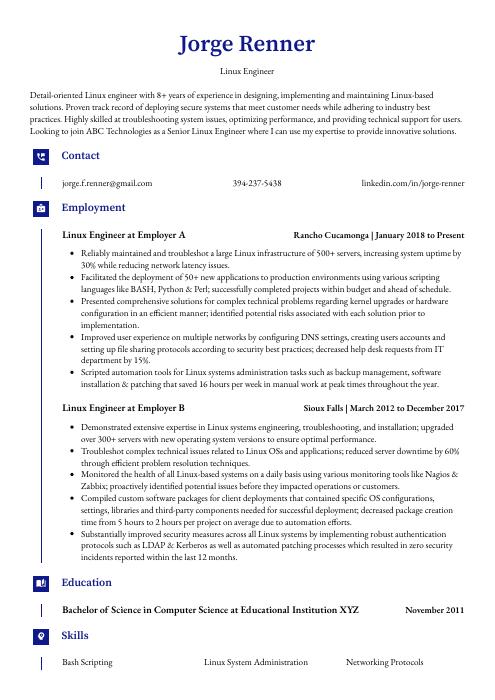 Gharial
Gharial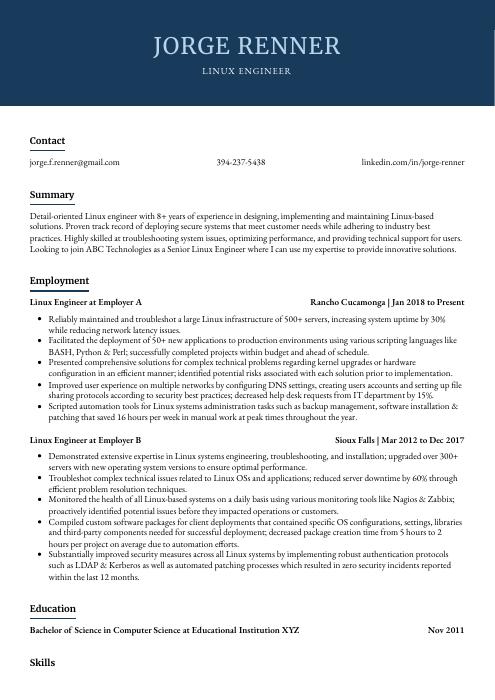 Bonobo
Bonobo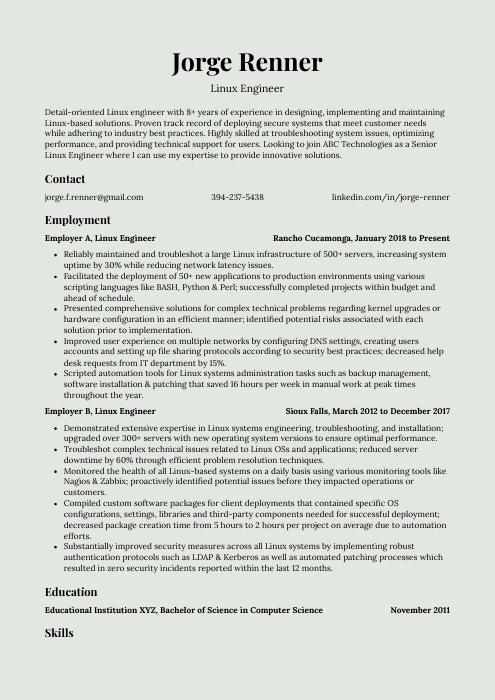 Saola
Saola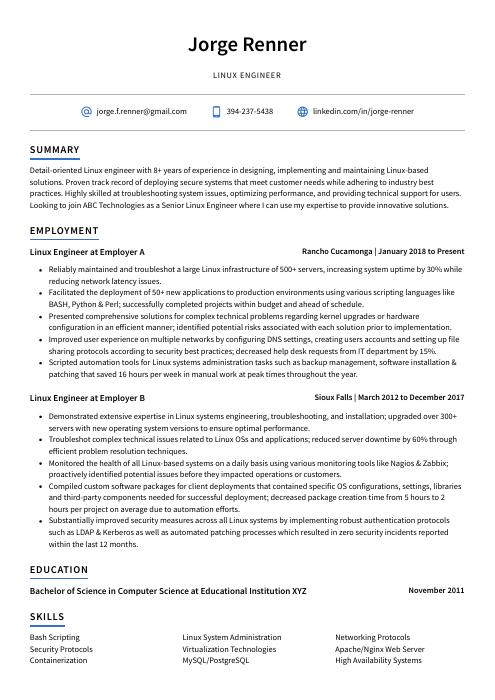 Axolotl
Axolotl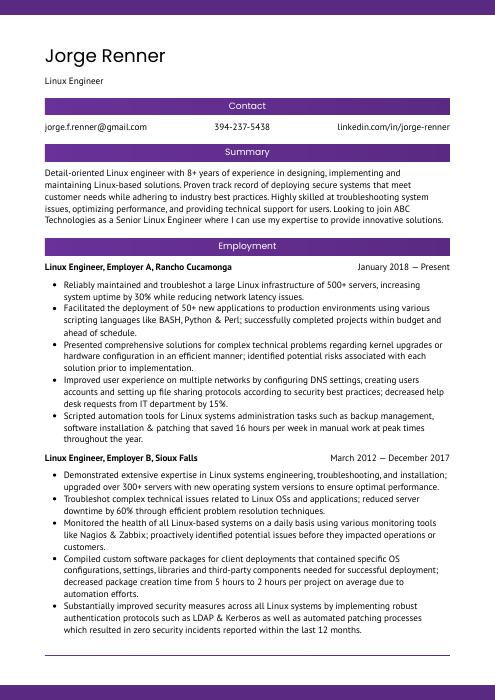 Jerboa
Jerboa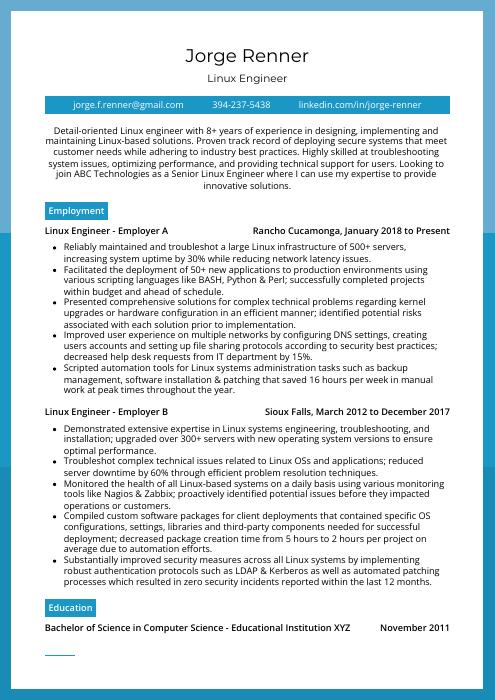 Rhea
Rhea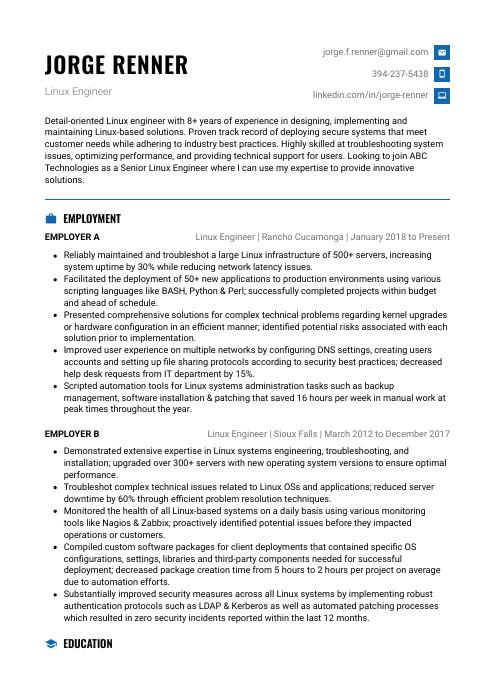 Echidna
Echidna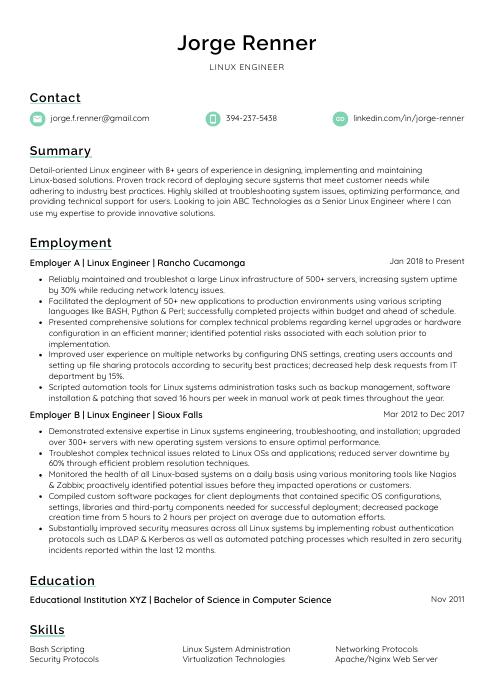 Lorikeet
Lorikeet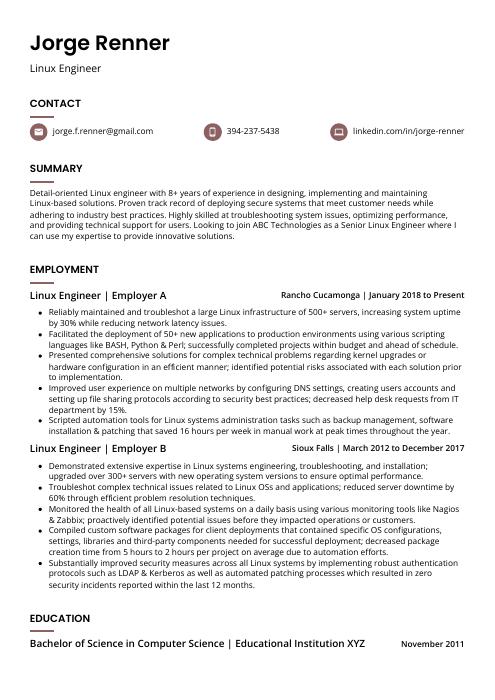 Fossa
Fossa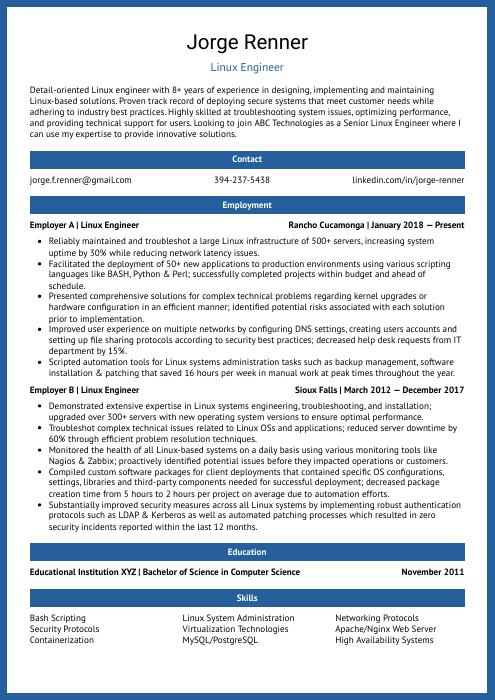 Ocelot
Ocelot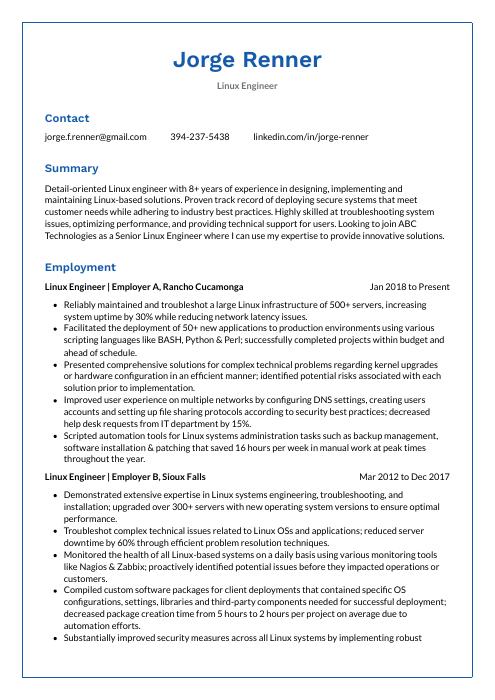 Markhor
Markhor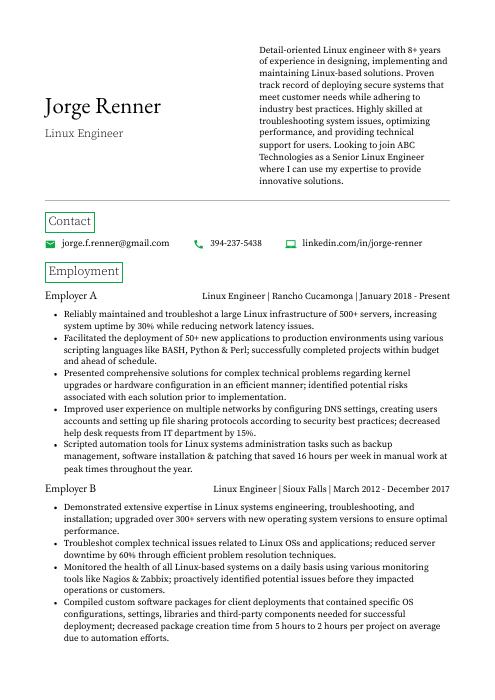 Quokka
Quokka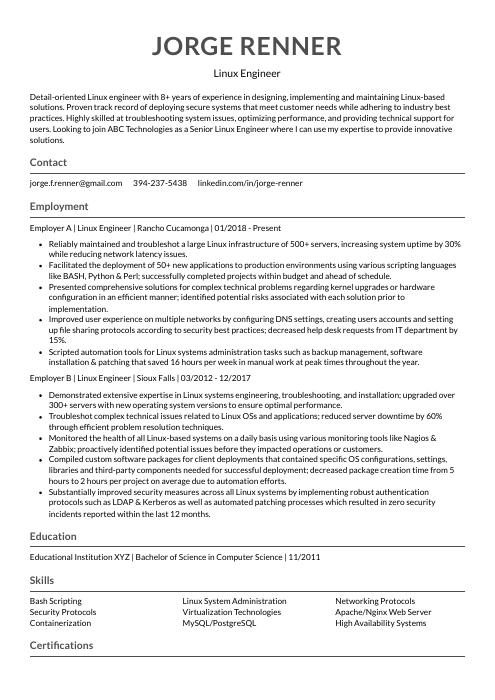 Indri
Indri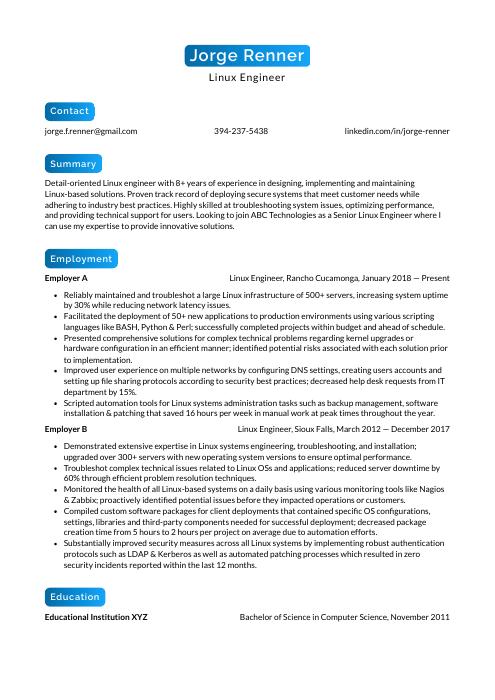 Kinkajou
Kinkajou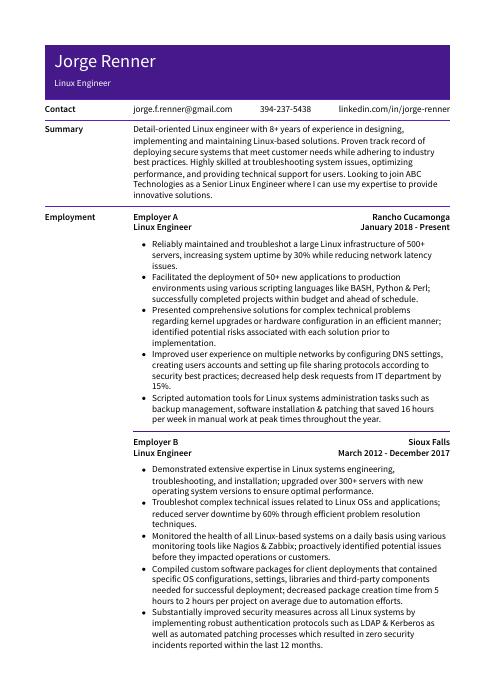 Pika
Pika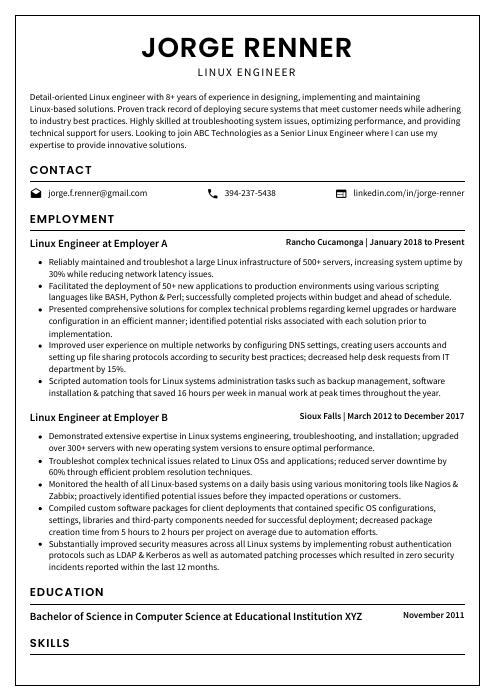 Cormorant
Cormorant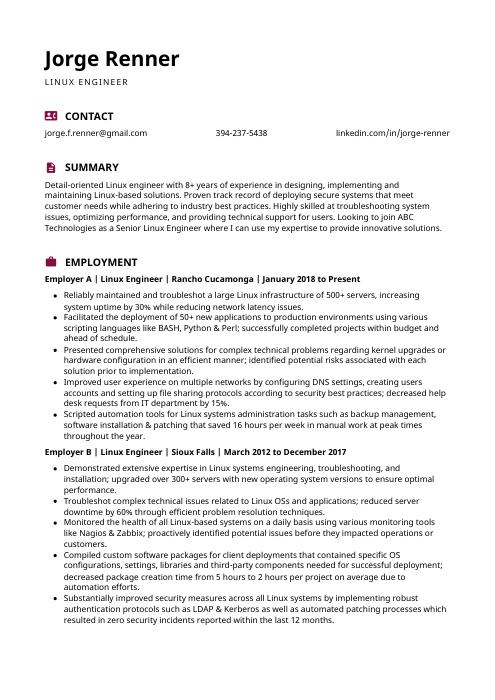 Hoopoe
Hoopoe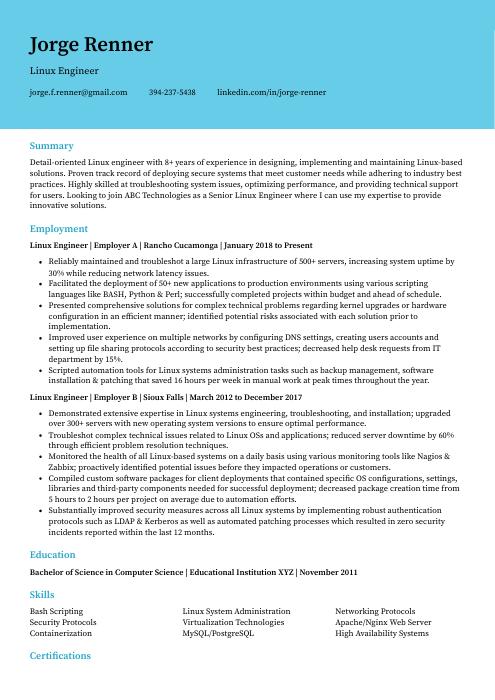 Dugong
Dugong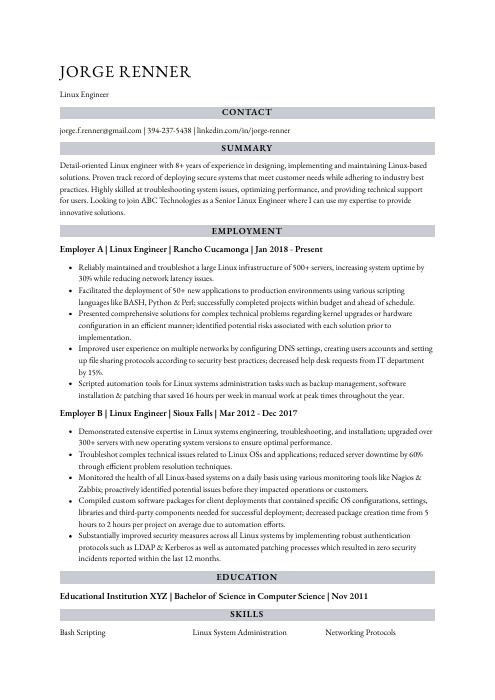 Numbat
Numbat Rezjumei
Rezjumei
